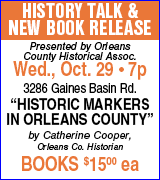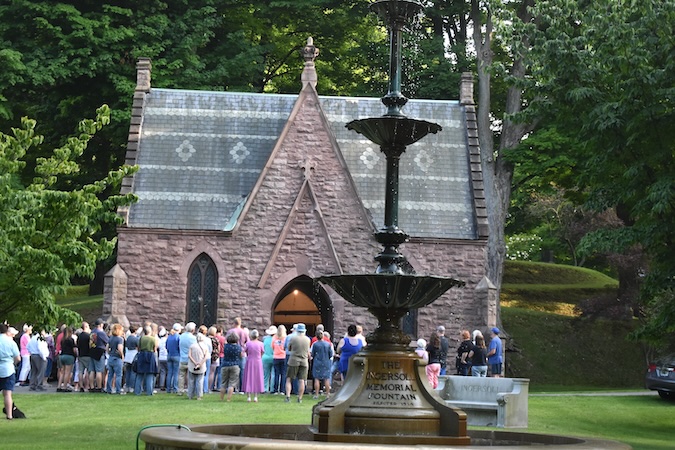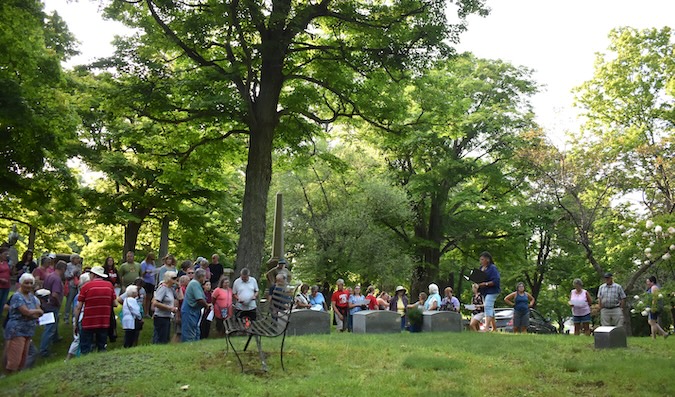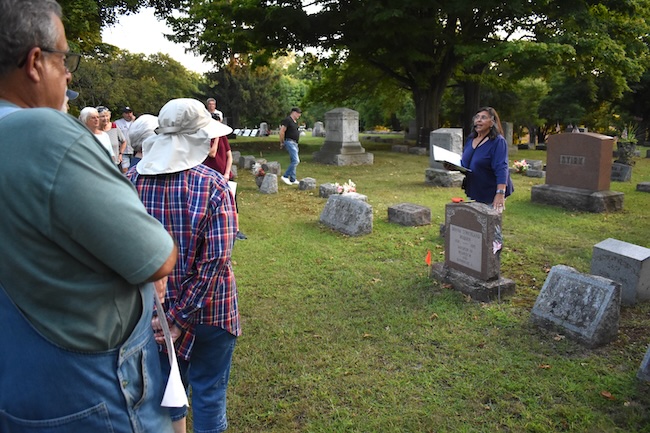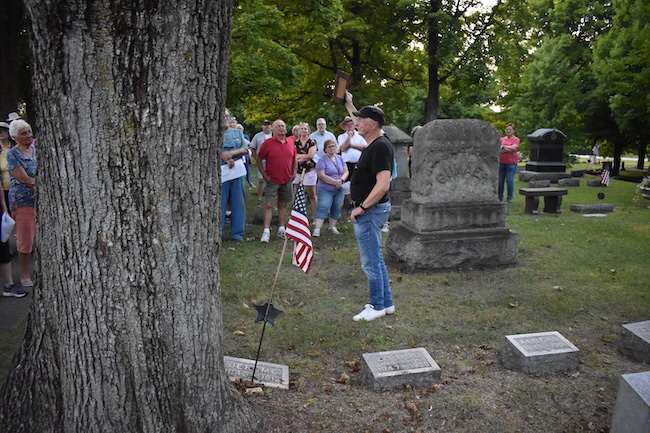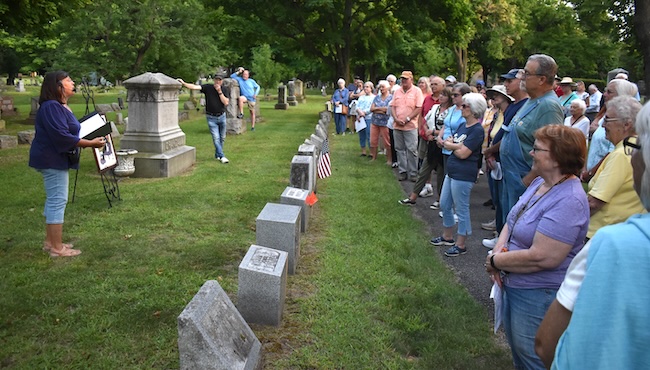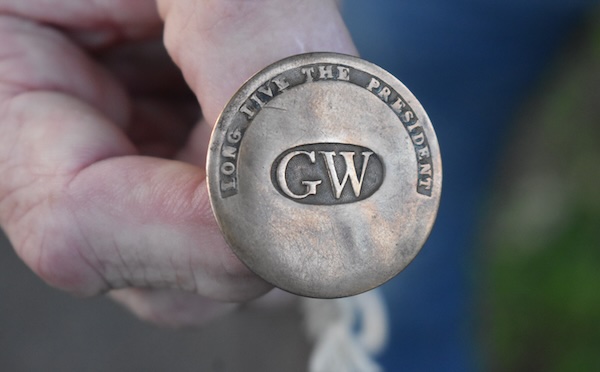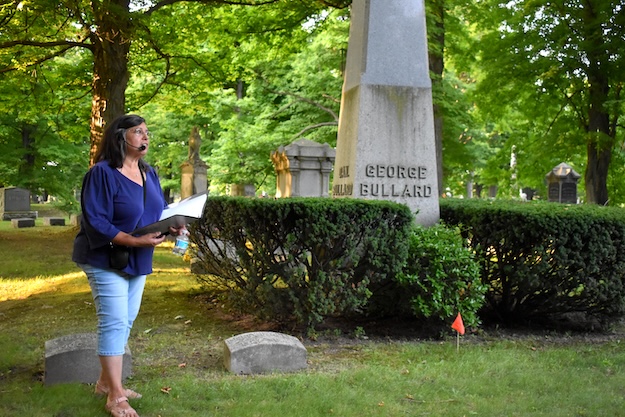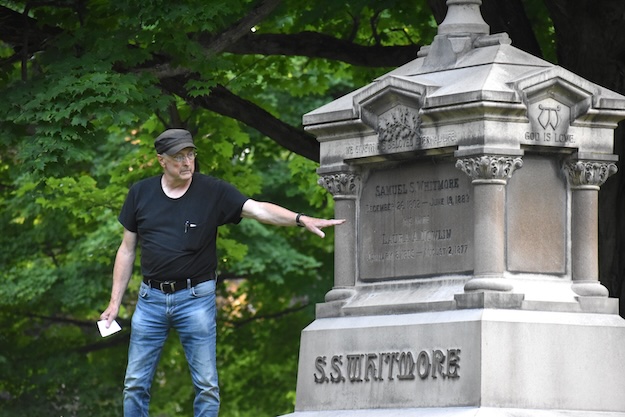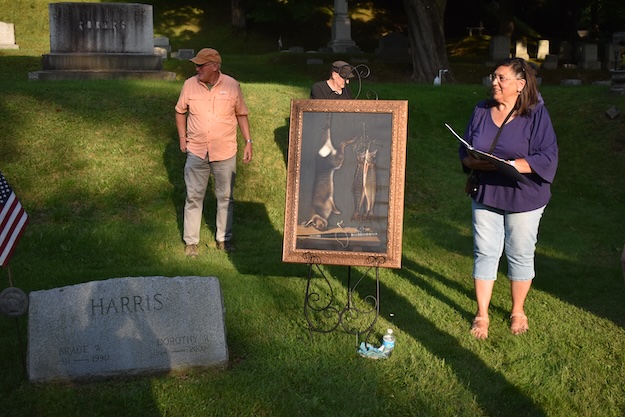Mount Albion tour brings 100 to learn about lore of historic cemetery
Photos by Tom Rivers
ALBION – About 100 people gather outside the chapel at Mount Albion Cemetery at the start of a cemetery tour on Sunday evening. The Ingersoll Memorial Foundation is in front.
The event closed out the four cemetery tours organized by the Orleans County Historical Association. Other tours included West Ridgeway Cemetery, the Orleans County “Poorhouse Cemetery” in Albion, St. Mary’s Cemetery in Medina.
The Mount Albion tour drew the biggest crowd. People were able to go inside the chapel which is dedicated in memory of former Albion Mayor Donna Rodden.
Albion Village Historian Sue Starkweather Miller led the tour with retired county historian Bill Lattin. Starkweather Miler said the chapel from 1875 needs significant repairs to the roof and other improvements.
A committee has been formed to spearhead fundraising for the project, which could top $100,000. Besides Starkweather Miller, other committee members include Tony Wynn, Toni Plummer, Tim Archer and David Snell.
Sue Starkweather Miller discusses how on Aster Day people decorate the gravestones of loved ones with asters, flowers which are a sign of remembrance. Aster Day used to be a big celebration at Mount Albion around Sept. 15.
Mount Albion was developed in the rural cemetery movement, creating a park-like setting. It was named to the National Register of Historic Places in 1976, the first site in Orleans County on the National Register.
There are about 22,000 people buried in the cemetery but not all have gravestones. The clerk’s book at the cemetery keeps a record of everyone at Mount Albion, Lattin said.
Sue Starkweather Miller shares about Donna Strickland Rodden, the first woman to serve as mayor of Albion. She was in that role from 1973 to 1983. She was a big proponent of historic preservation and pushed to have Mount Albion and the downtown business district named to the national registers of historic places.
She was a “brilliant woman” who earned two doctorates and also a master’s degree in journalism. Rodden worked in New York City before returning to her hometown where she was a school librarian and class advisor, as well as the village mayor. She also ran a gift shop and wrote a song about Mount Albion that was played at the cemetery tour called, “Top of the Tower.”
Bill Lattin holds a carved frame made by Jerome Gumaer, who lived from 1843 to 1912. Gumaer carved the frame while a prisoner of war at the Libby Prison at the Confederate capital of Richmond, Va.
Sue Starkweather Miller discusses the life of Henry “Hank” Porter who worked as a chief illustrator for Disney. Porter joined Disney in 1936, and worked on Snow White and the Seven Dwarfs, including the scene when the Dwarfs leave the mine singing “Heigh-Ho, Heigh-Ho, it’s home from work we go.”
He was part of the team that created Fantasia and Donald Duck. Porter also is credited with the iconic looping “D” is Disney’s signature.
During the World War II era, he was one of Disney’s most prolific artists, creating more than a thousand insignia and emblems for the military, other US Government agencies and charity organizations involved in the war effort, according to an article in Cartoon Research.
Porter died of cancer at age 50 in 1950. Lattin showed a self portrait by Porter in 1921 when he was in art school at the Chicago Academy of Fine Arts. Porter painted himself lighting a cigarette.
Bill Lattin shows a button that has been in his family for generations. Robert Capstick, a Civil War soldier, gave it to Lattin’s great-grandmother Sarah Harding who used to live on West Countyhouse Road. Capstick was destitute but he had the brass button and gave it to Harding in appreciation for nursing him back to health.
The button is from the inauguration of George Washington in 1789 and declares “Long Live The President.” Capstick is buried at Mount Albion.
Sue Starkweather Miller highlights George Bullard, a state assemblyman and attorney. He was very active in local civic affairs. In his will he left 24 acres to the Village of Albion that became Bullard Park. The park opened in 1928.
Bill Lattin speaks at monument for the Whitmore family, which he said is one of his favorites at Mount Albion. The monument is shaped like a houses. It has oaks and acorns, which are symbols for strength and endurance.
Lattin said the monument reflects the patriarchy of the day. It lists the name of the man, Samuel S. Whitmore (1802 to 1883), in big bold letters. His spouse, Laura Nowlin, is referred to as “his wife” in smaller letters. Very seldom, if ever, is there a monument that lists a woman’s spouse as “her husband,” Lattin noted.
Mount Albion was considered a pre-eminent place to be buried, a “status cemetery,” Lattin said. Many people who weren’t from Albion opted to have their grave site at Mount Albion, he said.
Sue Starkweather Miller discusses the life of George D. Harris, a prominent local builder and contractor. His office was on the canal. He died in 1918 at the age of 50.
The painting is by Peter West, who gave it to Harris in exchange for work. The rod and reel in the painting were owned by Harris. (West’s grave was also a stop on the cemetery tour. He was a professional animal painter.)
Three of Harris’s granddaughters attended the tour on Sunday, and his grandson listened by speaker phone.
As a contractor Harris built many new homes in Albion and redesigned others, including the former Swan Library, the Trolley Depot next to Swan Library, Jacob Landauer’s home on West State Street, the Baptist Parsonage, remodeled the Citizen’s National Bank, remodeled the Village Hall, built the Arnold Gregory Memorial Hospital and built a high school at the two bridges in Carlton which has since been demolished.













